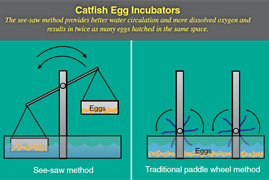This page has been archived and is being provided for reference purposes only. The page is no longer being updated, and therefore, links on the page may be invalid.
USDA Researchers Seek New Ways to Boost Catfish Production
By Sandra AvantNovember 22, 2010
A U.S. Department of Agriculture (USDA) scientist is exploring new ways to enhance farm-raised catfish production with a device he calls the "see-saw."
Les Torrans, a fish biologist with USDA's Agricultural Research Service (ARS), has built a vertical-lift egg incubator designed to provide a better mix of dissolved oxygen to boost hatching rates of catfish eggs. Torrans works at the ARS Catfish Genetics Research Unit of the Thad Cochran National Warmwater Aquaculture Center located at the Mississippi State University (MSU) Delta Branch Experiment Station in Stoneville, Miss.
ARS is USDA's principal intramural scientific research agency. This research supports the USDA priority of promoting international food security.
Before constructing the see-saw, Torrans discovered evidence that verified precisely how oxygen levels affect catfish egg development and hatching. He then teamed with James Steeby, MSU associate professor emeritus, to develop specific dissolved-oxygen management recommendations for catfish hatcheries.
According to Steeby and Torrans, data collected on catfish egg and fry metabolism showed that variable hatch was frequently caused by insufficient dissolved oxygen in the water. Poor water circulation around and through egg masses contributed to the problem.
Stress caused by low levels of dissolved oxygen, resulting from poor water circulation through egg masses at higher egg loading rates, can reduce the hatching rate, according to Torrans. The see-saw is designed to improve hatch with higher egg loading rates.
With the see-saw system, egg masses are dipped in water and then lifted out before being dipped again. The eggs remain wet, enabling them to exchange gas across the egg membrane. Because there is usually more oxygen in air than in water, the see-saw can take advantage of the water dipping to maintain developing eggs' moisture while using the air for oxygen delivery.
Using the see-saw may allow hatchery operators to increase egg hatch rate, while using half as much water and space as traditional systems, according to Torrans.


